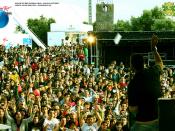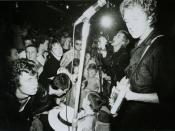Many of us are familiar with the "punk rock" sub-culture, or "scene," wherein drugs, alcohol, piercings, tattoos, and brightly colored hair are acceptable, or so it seems to an outsider. Most people that never get involved, however, do not see how this volatile, extremist group of people has been able to influence youth, music, and society as a whole. They also never get an opportunity to experience the positive role models, influences, and images that punk can bring to a teenager that has problems with their self-identity. Much of the "scene" influences teens to vote, to clean up their neighborhoods, and to be a tolerant member of a modern society.
"Punk" began as a rejection of society, a system of "politics of boredom" that began in the late 1960's as an alternative, artsy movement. Bands such as Velvet Underground and the Stooges created musically untalented precedents for the edgy kids of the raw, abstract art movements.
A.S. Van Dorston describes these bands as "bored with the music scene and bored with being poor." Eventually, though, these bored teenagers would influence other bands to become alternative to society's standards. In 1972, a band known as the New York Dolls came into the movement's spotlight, and they attained near instant popularity with American and English members of the movement. Their first English show, an opening spot for Rod Stewart, opened to a crowd of 13,000 people (Van Dorston). The Dolls, as they were affectionately known, were characterized by loud, raucous riffs, rude and autobiographical lyrics, and outrageous on stage antics, including, but not limited to, cross dressing, self-mutilation, and openly harassing members of the audience. Many of these actions would later influence fans to create similar bands. In fact, Malcolm McLaren, the future manager of the infamous Sex Pistols, changed his...


